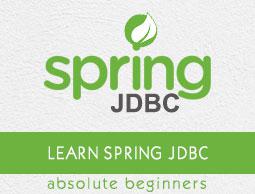Spring JDBC - ResultSetExtractor Interface
The org.springframework.jdbc.core.ResultSetExtractor interface is a callback interface used by JdbcTemplate's query methods. Implementations of this interface perform the actual work of extracting results from a ResultSet, but don't need to worry about exception handling.
SQLExceptions will be caught and handled by the calling JdbcTemplate. This interface is mainly used within the JDBC framework itself. A RowMapper is usually a simpler choice for ResultSet processing, mapping one result object per row instead of one result object for the entire ResultSet.
Interface Declaration
Following is the declaration for org.springframework.jdbc.core.ResultSetExtractor interface −
public interface ResultSetExtractor
Usage
Step 1 − Create a JdbcTemplate object using a configured datasource.
Step 2 − Use JdbcTemplate object methods to make database operations while parsing the resultset using ResultSetExtractor.
Example
Following example will demonstrate how to read a query using JdbcTemplate class and ResultSetExtractor interface. We'll read available record of a student in Student Table.
Syntax
public List<Student> listStudents() {
String SQL = "select * from Student";
List <Student> students = jdbcTemplateObject.query(SQL,
new ResultSetExtractor<List<Student>>(){
public List<Student> extractData(
ResultSet rs) throws SQLException, DataAccessException {
List<Student> list = new ArrayList<Student>();
while(rs.next()){
Student student = new Student();
student.setId(rs.getInt("id"));
student.setName(rs.getString("name"));
student.setAge(rs.getInt("age"));
student.setDescription(rs.getString("description"));
student.setImage(rs.getBytes("image"));
list.add(student);
}
return list;
}
});
return students;
}
Where,
SQL − Select query to read students.
jdbcTemplateObject − StudentJDBCTemplate object to read student object from database.
ResultSetExtractor − ResultSetExtractor object to parse resultset object.
To understand the above-mentioned concepts related to Spring JDBC, let us write an example which will select a query. To write our example, let us have a working Eclipse IDE in place and use the following steps to create a Spring application.
| Step |
Description |
| 1 |
Update the project Student created under chapter Spring JDBC - First Application. |
| 2 |
Update the bean configuration and run the application as explained below. |
Following is the content of the Data Access Object interface file StudentDAO.java.
package com.howcodex;
import java.util.List;
import javax.sql.DataSource;
public interface StudentDAO {
/**
* This is the method to be used to initialize
* database resources ie. connection.
*/
public void setDataSource(DataSource ds);
/**
* This is the method to be used to list down
* all the records from the Student table.
*/
public List<Student> listStudents();
}
Following is the content of the Student.java file.
package com.howcodex;
public class Student {
private Integer age;
private String name;
private Integer id;
public void setAge(Integer age) {
this.age = age;
}
public Integer getAge() {
return age;
}
public void setName(String name) {
this.name = name;
}
public String getName() {
return name;
}
public void setId(Integer id) {
this.id = id;
}
public Integer getId() {
return id;
}
}
Following is the implementation class file StudentJDBCTemplate.java for the defined DAO interface StudentDAO.
package com.howcodex;
import java.util.List;
import java.util.ArrayList;
import javax.sql.DataSource;
import org.springframework.jdbc.core.JdbcTemplate;
public class StudentJDBCTemplate implements StudentDAO {
private DataSource dataSource;
private JdbcTemplate jdbcTemplateObject;
public void setDataSource(DataSource dataSource) {
this.dataSource = dataSource;
this.jdbcTemplateObject = new JdbcTemplate(dataSource);
}
public List<Student> listStudents() {
String SQL = "select * from Student";
List <Student> students = jdbcTemplateObject.query(SQL,
new ResultSetExtractor<List<Student>>(){
public List<Student> extractData(
ResultSet rs) throws SQLException, DataAccessException {
List<Student> list = new ArrayList<Student>();
while(rs.next()){
Student student = new Student();
student.setId(rs.getInt("id"));
student.setName(rs.getString("name"));
student.setAge(rs.getInt("age"));
student.setDescription(rs.getString("description"));
student.setImage(rs.getBytes("image"));
list.add(student);
}
return list;
}
});
return students;
}
}
Following is the content of the MainApp.java file.
package com.howcodex;
import java.util.List;
import org.springframework.context.ApplicationContext;
import org.springframework.context.support.ClassPathXmlApplicationContext;
public class MainApp {
public static void main(String[] args) {
ApplicationContext context =
new ClassPathXmlApplicationContext("Beans.xml");
StudentJDBCTemplate studentJDBCTemplate =
(StudentJDBCTemplate)context.getBean("studentJDBCTemplate");
List<Student> students = studentJDBCTemplate.listStudents();
for(Student student: students){
System.out.print("ID : " + student.getId() );
System.out.println(", Age : " + student.getAge());
}
}
}
Following is the configuration file Beans.xml.
<?xml version = "1.0" encoding = "UTF-8"?>
<beans xmlns = "http://www.springframework.org/schema/beans"
xmlns:xsi = "http://www.w3.org/2001/XMLSchema-instance"
xsi:schemaLocation = "http://www.springframework.org/schema/beans
http://www.springframework.org/schema/beans/spring-beans-3.0.xsd ">
<!-- Initialization for data source -->
<bean id = "dataSource"
class = "org.springframework.jdbc.datasource.DriverManagerDataSource">
<property name = "driverClassName" value = "com.mysql.jdbc.Driver"/>
<property name = "url" value = "jdbc:mysql://localhost:3306/TEST"/>
<property name = "username" value = "root"/>
<property name = "password" value = "admin"/>
</bean>
<!-- Definition for studentJDBCTemplate bean -->
<bean id = "studentJDBCTemplate"
class = "com.howcodex.StudentJDBCTemplate">
<property name = "dataSource" ref = "dataSource" />
</bean>
</beans>
Once you are done creating the source and bean configuration files, let us run the application. If everything is fine with your application, it will print the following message.
ID : 1, Age : 17
ID : 3, Age : 18


